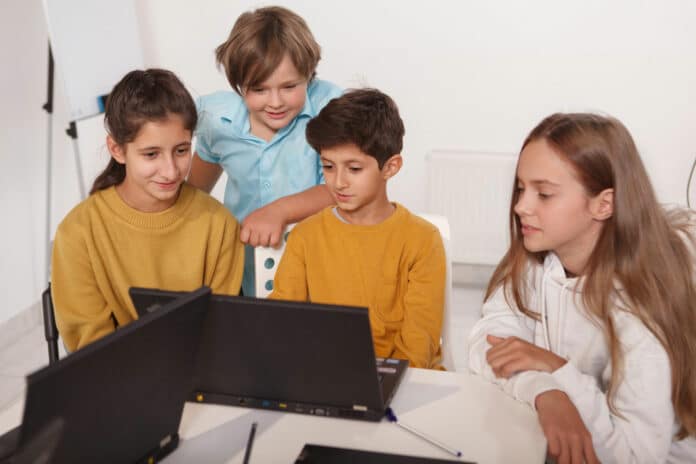When babies start talking, they have very few words. They often say ‘da,’ which can mean many things. A study from MIT and Harvard says that adults can understand babies by knowing the context and common mistakes babies make when talking.
Researchers used lots of recorded conversations between kids and adults to figure out how adults understand what little kids are saying. They made computer models for this. Models that only used the sounds kids made could have worked better. The best models used past conversations as clues to understand what kids meant. These models improved when they were trained in many adult-child conversations. This shows that adults are good at understanding kids with context, which helps kids learn language.
Roger Levy, a professor of brain and cognitive sciences at MIT, said, “An adult with lots of listening experience is bringing to bear extremely sophisticated mechanisms of language understanding, and that is clearly what underlies the ability to understand what young children say. At this point, we don’t have direct evidence that those mechanisms directly facilitate the bootstrapping of language acquisition in young children. However, I think it’s plausible to hypothesize that they are making the bootstrapping more effective and smoothing the path to successful language acquisition by children.”
Levy and Elika Bergelson, a psychology professor at Harvard, are the top authors of the study published in Nature Human Behavior. Stephan Meylan, a postdoc at MIT, is the principal author.
Many studies focus on how kids learn to talk, but in this project, the researchers turned the question around. They studied how adults understand what kids are saying. They found that adults use their knowledge of how people usually talk and what they might talk about to understand kids. This approach, called ‘noisy channel listening,’ helps adults understand what they hear, especially in noisy or challenging situations.
In this study, the researchers wanted to see if adults could use the same listening technique to understand what young kids, still learning to talk, are saying. They found that understanding children’s speech is even more complicated than understanding adult speech, which is already quite challenging.
To do this study, they used conversations recorded at Brown University from the early 2000s. These recordings had kids aged 1 to 3 talking to their caregivers. They included written transcriptions of the sounds the kids made and what the transcriber thought the child meant.
The researchers had data from kids’ speech, about 18 million words. They used this data to train computer models. These models tried to guess what words the kids were saying by looking at how the words sounded. They used different models that varied in how much they knew about what people talk about, grammar, and the mistakes kids make when talking. Some models only looked at one or two words before the target word, while others looked at up to 20 previous things the kids said.
The models that just used how the words sounded could have worked better. The best models were the ones who knew a lot about what people usually talk about, how sentences are structured, and what words kids are likely to use (like ‘ball’ or ‘dog’ rather than ‘mortgage’). These models also got better at guessing as they looked at more words from earlier in the conversation.
The study found that when adults listen to children, they understand what the child is saying based on what was said before. For instance, if they talked about a dog earlier, they might think ‘da’ means ‘dog.’
This is something people often do when talking to other adults, using what they know from past experiences. The study also shows that when adults listen to kids, they consider the mistakes kids usually make when pronouncing words, like saying ‘weed’ instead of ‘read.’
Next, the researchers want to see how adults’ listening and responses to kids help them learn language better.
Bergelson said, “Most people prefer to talk to others, and I think babies are no exception to this, especially if there are things that they might want, either in a tangible way, like milk or to be picked up, but also in an intangible way in terms of just the spotlight of social attention. It’s a feedback system that might push the kid, with their burgeoning social and cognitive skills and everything else, to continue down this path of trying to interact and communicate.”
The researchers plan to combine models of how children learn language with their new adult response model. This way, children can learn better with feedback from the adult model. They want to determine how kids use this feedback to understand what adults will get. The study was funded by the National Science Foundation, the National Institutes of Health, and a grant from the Simons Center for the Social Brain to MIT’s Department of Brain and Cognitive Sciences.
This study reveals that adults’ comprehension of children’s speech relies heavily on context and prior knowledge. Understanding children’s often limited and seemingly nonsensical language is challenging, and adults use their expectations and past experiences to make sense of it.
By using conversational context and anticipating common mispronunciations, adults help children in their language development. The findings shed light on the complex dynamics of adult-child interactions. They lay the foundation for further research into how children use adult feedback to shape their language expectations.
Journal reference:
- Meylan, S.C., Foushee, R., Wong, N.H. et al. How adults understand what young children say. Nature Human Behaviour. DOI: 10.1038/s41562-023-01698-3.
